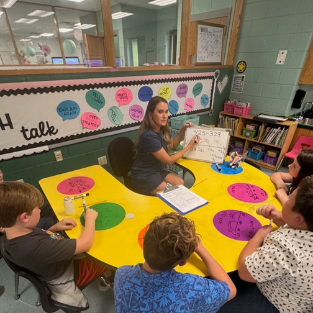Closing the Funding Gap: Ensuring Kentucky’s Education Budget Delivers
Closing the Funding Gap: Ensuring Kentucky’s Education Budget Delivers

In 1989, the Kentucky Supreme Court, in Rose vs. the Council for Better Education (commonly referred to as the Rose decision), declared the entire state system of public education unconstitutional. The court found that Kentucky’s public education system failed to meet the requirements of Section 183 of the state constitution, which mandates an "efficient system of common schools throughout the state." This lawsuit was prompted by major deficiencies in both the adequacy of public school funding and the equity of that funding in districts across the state. From this decision, the Kentucky legislature passed the Kentucky Education Reform Act, which, among many overhauls, included a new funding formula known as the Support Education Excellence in Kentucky (SEEK).
The Kentucky Association of School Superintendents commends the legislature for passing an education budget that moves us closer to adequate funding. Currently, however, a funding shortfall exists and it’s imperative this gap is closed in order for the budget to work and be made whole. Inadequate funding harms the entire budget process.
How is SEEK Calculated?
Every two years, Kentucky lawmakers set a per-student base funding amount multiplied by the district’s average daily attendance from the previous year. This is just a starting point, however, and not a guaranteed amount per student.
Next, add-ons adjust funding based on student needs:
- At-risk students (free lunch eligible) = number of students x 15% of the base funding per student.
- Home-hospital students = previous year’s average daily attendance x the base amount minus $100.
- Exceptional children = funding varies by need level and the number of students (low, moderate, or high incidence).
- Limited English proficiency students = number of students x 9.6% of the base funding per student.
- Transportation funding is based on distance, frequency, and type of travel.
After calculating adjusted base funding,
local effort is subtracted. Districts must contribute
30 cents per $100 of assessed property value, reducing the amount provided by the state. Wealthier districts receive less state aid, while poorer districts receive more to promote fairness.
Districts can raise local taxes beyond the required amount:
Tier One: Up to 17.5% more, with state equalization for poorer districts.
Tier Two: Up to 30% more (requires voter approval) but gets no state equalization.
A
hold harmless provision ensures no district receives less than it did in 1992.
In short, SEEK funding aims to balance resources so all students, regardless of their district’s wealth, have access to similar educational opportunities.
Why do we have a funding gap?
Funding gaps are not new. When developing the budget for SEEK, estimates must occur as legislators are projecting two years out. Based on any number of factors within the formula, a surplus or shortfall will almost always happen. Over the past 15 years, shortfalls have occurred 4 times. But during the last fiscal year, there was a $156.3 million SURPLUS in SEEK funds that were swept to the state general fund.
Factors that impact SEEK include changes in:
- Enrollment
- Average Daily Attendance
- At-risk students
- Students w/disabilities and category of that disability
- Students utlizing home-hospital services
- Students with limited English proficiency
- Transportation patterns within the district
- Increase or decrease in property values
- Local district tax rates
Since 2022, total enrollment has increased by almost 4,000 students across the state. In that same time frame, Kentucky public schools have seen an increase of over 10,000 at-risk students, 12,000 students with limited English proficiency, and 9,000 students with a disability. The shifts in these groups combined with a large variance in local property values across the state make the SEEK estimate an imperfect science. And yet, the shortfall is less than 1.5% of the total SEEK budget.
Why can’t local districts just pick up the cost?
A common argument is that local school districts have contingencies to cover just this sort of thing. In Kentucky, 2% of a local school district’s budget is REQUIRED to be in contingency, while at least 5% is recommended. In fact, many accountants recommend at least 3 months of operating costs in reserve. Much like people who try to save a portion of their income, school districts do the same.
The average school district in Kentucky has around 2200 students. When you are dealing with thousands of people (students and staff) being transported, fed, utilizing hundreds of thousands of square feet of buildings, ensuring their safety, and supporting the educational efforts of the next generation, there are many expenses. The roof has leaks, the heating unit stops working, an extra teacher is provided for a program needed for students, the bus breaks down - these costs are why a district has a contingency. In many districts, the contingency is developed because of expected large future expenses like a building project, staff raises, or expanded programs.
What must happen now?
It is crucial the Kentucky Legislature close this shortfall. The money is there. Last year, over $156 million from the SEEK fund lapsed back to the general fund. To close this year’s gap, 25% of that money is needed - a small drop in the bucket. School districts utilize expected SEEK dollars to create their budgets for the next year. Not closing the gap will lead to budget shortfalls locally, which could impact jobs, whether or not districts can give raises, and uncertainty in the budgeting process moving forward. This budget was a good education budget. It should not be short changed because of the SEEK shortfall.
The Kentucky Association of School Superintendents encourages every superintendent to reach out to their local legislators to discuss more specific talking points and how this shortfall could affect your district and your long-term plans. Now is the time to act to ensure we continue to focus on Kentucky public education funding.








